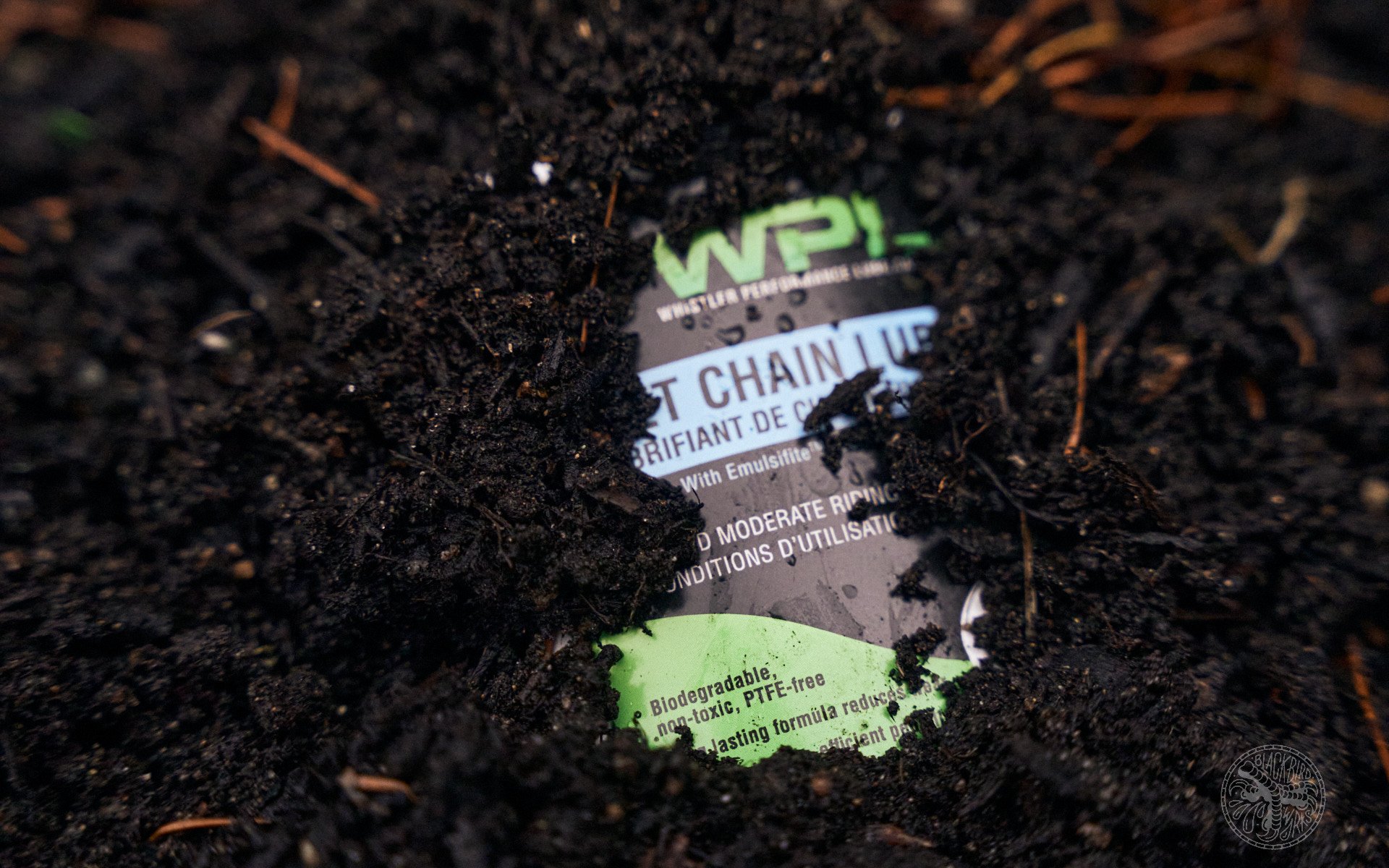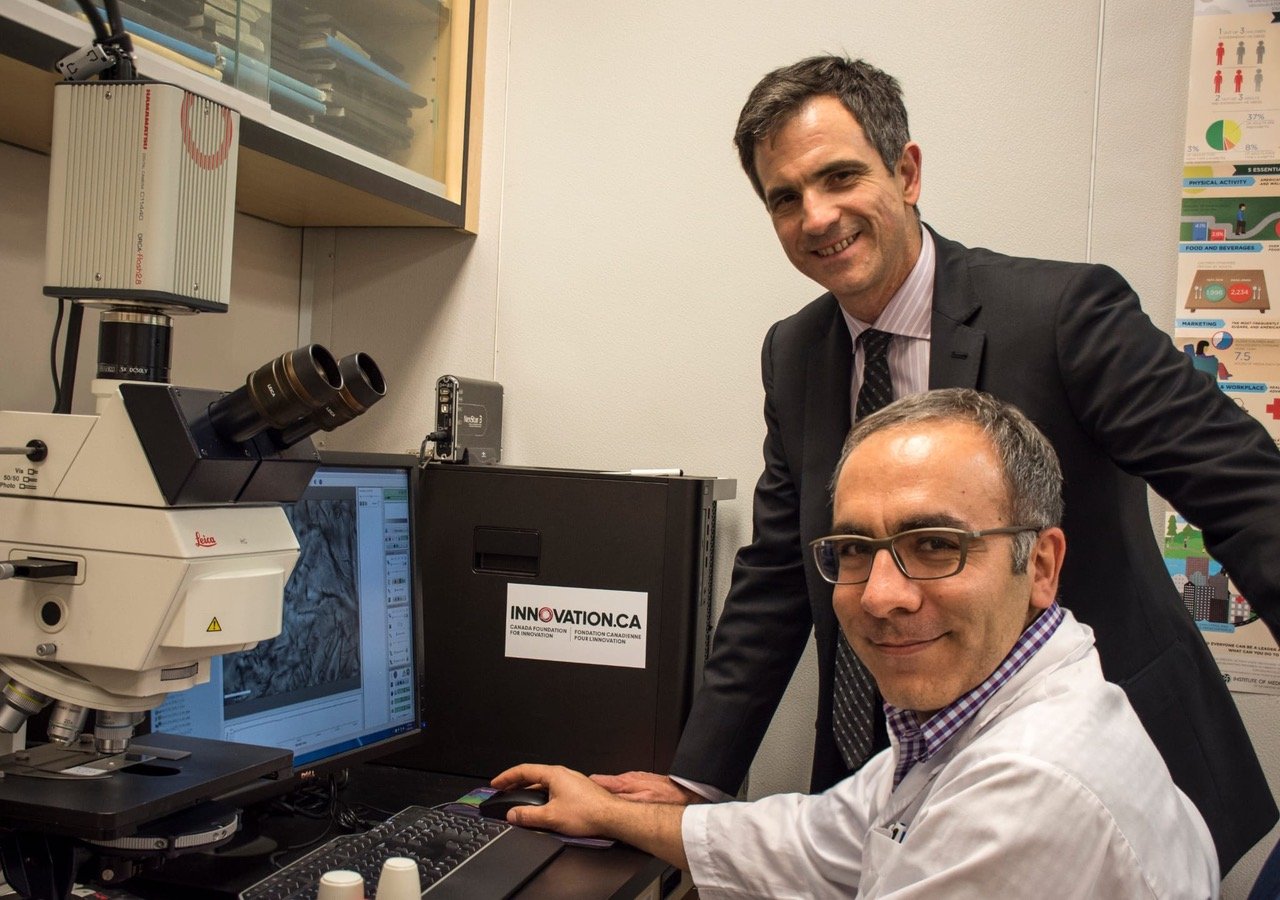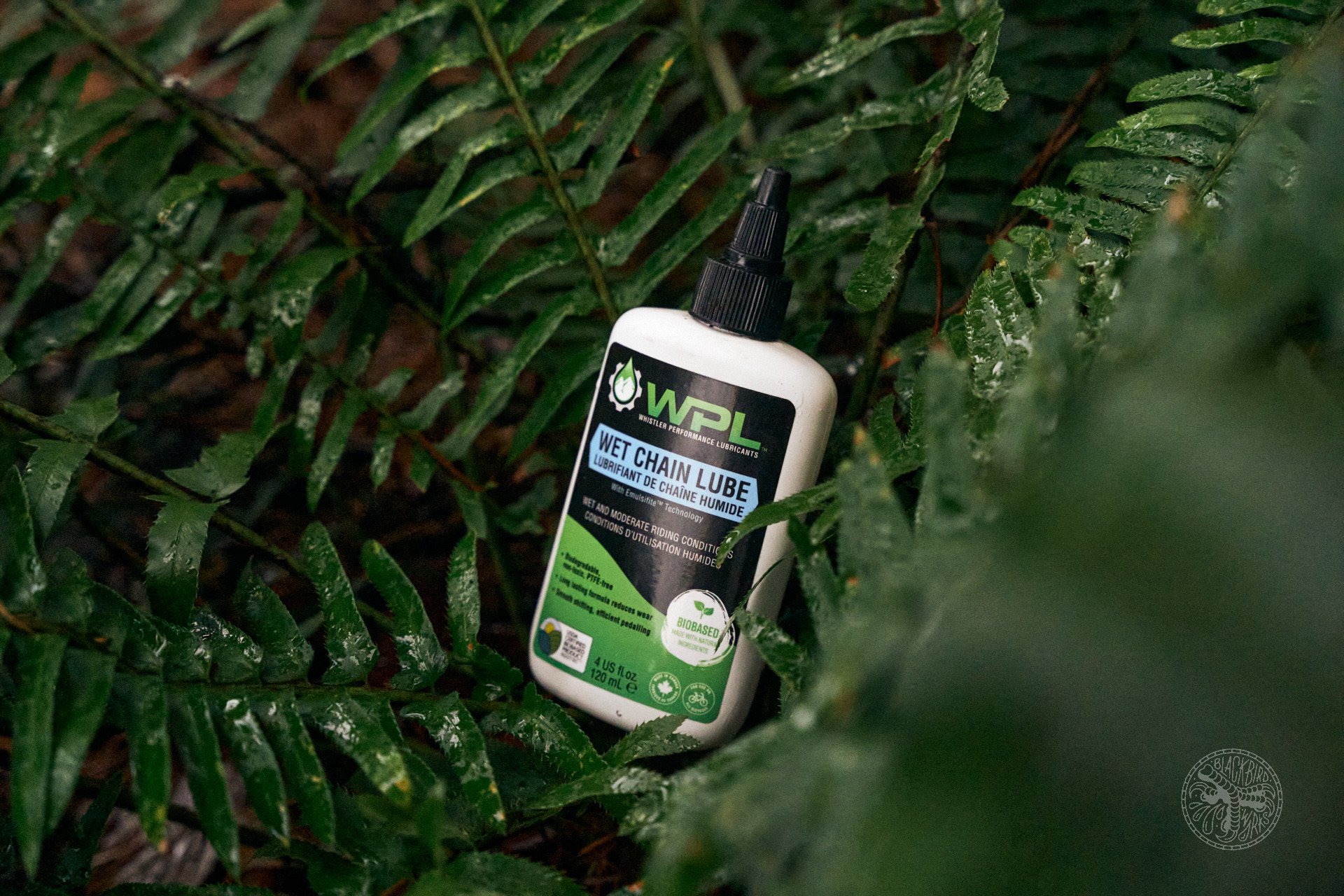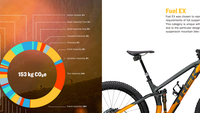
Let's Get Nerdy
What's the Difference Between Bio-Based and Biodegradable?
Some of our 2-minute expert articles from the recent past have covered bio-based lubricants (fast or friction?), bio-based suspension oil, and tubeless sealant. In each case, we touched on how those product types work and included some environmental talking points. Bikes have long been held up as environmentally-friendly machines, but it's easy to forget the fact that some of the products we use to maintain our bicycles, like lube, grease, suspension oil, and tubeless sealant, are not environmentally friendly at all. Is it a better alternative than a car? Sure. But when we ride bikes for recreation, those comparisons fall by the wayside because at that point bikes are not substitutes for fossil fuel-powered transportation, they're toys we use to have fun. Of course there's nothing wrong with that, but it moves the goal posts in terms of impact.
Isaac Marangoni and his father, Alejandro, started Whistler Performance Labs (WPL) because they wanted to bring a line of Canadian-made bio-based products to market, to help reduce the environmental impact of biking without sacrificing performance. Alejandro is a professor in the department of food science at the University of Guelph, the Co-Director, Centre for Sustainable Nanomaterials Innovation, and Tier 1 Canada Research Chair in Food, Health and Aging. In case you're wondering why any of that matters as far as the efficacy of WPL's products, the answer is that a lot of the things that Alejandro has worked on and developed over the years - emulsions, oils, and nanomaterials - carry over into developing bio-based products that we can use on our bikes. The science he conducts uses knowledge about things found in nature to create or enhance products we use every day, often replacing more harmful predecessors in the process - exactly what he and Isaac set out to do with WPL.
Both are avid riders. Isaac grew up riding and racing bikes (primarily DH) and still loves to get a day in at the Whistler Bike Park whenever he has a chance. Alejandro commutes and likes to get road miles in whenever he can.
I posed some questions to them to learn a little more about what bio-based means, as well as some of the challenges of competing against traditional, petroleum-based manufacturers in the bicycle industry.

WPL co-founder Isaac Marangoni is a frequent visitor to the Whistler Bike Park.

Isaac again - always in a full face!

Alejandro Marangoni (top) is Isaac's father and a decorated professor and researcher at the University of Guelph. Also pictured is Saeed Mirzae, one of WPL's researchers.
Pete Roggeman / NSMB: WPL has committed to selling bio-based products. Bio-based sounds a lot like biodegradable, but they aren’t the same at all. Can you explain ‘bio-based’ and why the distinction between bio-based and biodegradable is important to understand?
Isaac Marangoni, WPL: Bio-based is different from biodegradable because the former describes the composition of the material (being made from a biological source) whereas biodegradable describes the ability for the material to decompose in nature if spilled or disposed of without recycling.
The issue with the term biodegradable is that there is no time limitation for something to be described as biodegradable so technically everything biodegrades given enough time. You want consumers to be able to differentiate between something that is going to biodegrade in 30 days vs. 300 years.
Something that is bio-based is going to biodegrade quickly because the base components of the material can be broken down by natural microbiological processes with the enzymatic catalysts that exist in the environment.
It is important that any product that has a consumable useage such as food packaging, machinery lubrication, and cleaning fluids are made from bio-based materials so that when they are disposed of there is a net zero impact on the environment as a result of their use. Just as we want a net zero carbon footprint from our transportation systems, it’s not sustainable to create persistent, enduring and toxic waste every time we use one of these items.
NSMB: What are some common misconceptions about biodegradable products? Thinking of greenwashing here, but are there others as well?
Isaac Marangoni: A common misconception is that because the label says “biodegradable” that it’s not “bad” for the environment. Anything that persists in eco-systems, incapable of being decomposed by the eco-system and therefore causes damage to organisms that encounter it, is “bad”. Importantly, compounds can be biodegraded into more toxic or persistent components. The end product matters. Biodegradable is unfortunately not specific enough of a term to accurately assess the sustainability of a product.
A common misconception about bio-based products is firstly their performance. Bio-based technology has not received the same scientific attention as petro-chemical products because of the cheapness of petroleum and the boom in that industry. But after factoring in the environmental cost that is passed on to all of us as a result of their useage, it’s actually more economical to use a bio-based material and now that the world realizes this, bio-based products are receiving more scientific attention which is resulting in products that perform just as well or better.
The issue with the term biodegradable is that there is no time limitation for something to be described as biodegradable so technically everything biodegrades given enough time. -Isaac Marangoni, co-founder, Whistler Performance Labs
NSMB: With all of the attention surrounding eco-conscious products, it’s logical to assume everyone would be producing bio-based products wherever possible, but they aren’t. So, what can you tell us about some of the challenges of designing and producing bio-based products that hold up to the needs of mountain bikers?
Isaac Marangoni: Producing a bio-based product is not as simple as just switching. Most brands of consumer products do not manufacture their goods from scratch and their manufacturing partners are not set up with either the right equipment, technology, or supply chains to produce the item in bio-based form. Anyone putting out a bio-based alternative is likely having to manage the whole production process from scratch which is very inefficient for a startup. And of course most innovation comes from startups, without them there would be no pressure on bigger market players to make any changes at all. So the limiting factor in this adoption of bio-based products is the supply chain as a whole, you have to create an entire industry to get one product out.
We have had to literally do everything from sourcing suppliers of each little component, to developing all the manufacturing Standard Operating Procedures, to finding equipment to use, all so that we can get our brand onto shelves. Building a brand is a big enough job on its own.
A second challenge that is more of a marketing challenge rather than an operational one is that bio-based products are “virtuous” products that do not necessarily create a personal advantage for the user. Most products sell because the brand has convinced the consumer that they are better off for it, even if it’s as silly as “drink this beverage because it gives you wings.” However when you are marketing a bio-based product, the simple fact of it being good for the planet only appeals to a portion of the market, the rest of the market cares more about themselves. So you must still compete for their personal preference as well as building a brand that is solving a macro problem simultaneously.
What about some other challenges you’ve encountered?
Some other challenges related specifically to this market and our brand would be the lack of transparency in the performance requirements of the products across the industry. Because there is no consensus on what makes a good chain oil, suspension oil, grease, etc… personal opinions can become propagated by followers of influential figures in the industry. One person’s subjective (and often unverifiable) opinion can create a perception of quality that can only be overcome by complete education of the opinion holders. It takes a lot of work to even discover what you should be attempting to create, let alone to actually create that desired outcome. And of course language barriers do not help this either - biking is a global marketplace.
What are some things that make you optimistic about the prospects for wider acceptance of bio-based products?
I am optimistic about the adoption of bio-based products in use cases where it makes absolute sense like food packaging, consumable chemicals, and clothing. Recyclable clothing is becoming more and more common especially in outdoor brands. Eventually it is inevitable that the most sustainable and economical solution is what prevails in any industry, and that’s bio-based products. It is simply not possible for petrochemicals to compete with bio-based chemicals on unit economics if you factor in the environmental cost of petrochemical usage, which can be done by looking at the carbon footprint differences of producing crude petroleum vs. crude vegetable oil, the fresh water requirements of petroleum production, the spillage into the environment of lubricants over their product lifecycle, and the inefficiencies of recycling lubricants and plastics. In the end, the best product wins! Choose bio-based.

That last point is critical to the big picture. It's easy to look at two products on a shelf and decide which one is the better choice for you as a user based on your individual values and criteria like ingredients and price. However, the cost of the product is a very different story if you weigh the environmental impact of the production of its components as well as its impact in use (just like ski wax, chain lube can come off your chain and end up in the ground, making its way to the water table, impacting streams, wildlife, and even drinking water) and proper disposal after end of life. Governments worldwide are trying to catch up and figure out ways to make companies responsible for the environmental impact of products they sell.
Currently, we may pay disposal fees for certain products like car tires or electronics. In future, as companies are required to be more accountable for the impact of those products - from production through to disposal - those fees will increase and/or show up on more and more products. In a perfect world, this would create economic incentives for companies to seek bio-based alternatives. Until then, it's up to the consumer to make choices with their wallet. Changing your chain lube won't save the planet, but if we all make better choices whenever we can manage them, those small things add up (and increase the effectiveness of the policies and other decisions that make the larger impacts). It all counts.
In the preparation of this article, Isaac also pointed me in the direction of the following write-up by Prof. Erica Penisini from the University of Guelph, an environmental engineer. She cites many sources on biodegradability of bio-based compounds vs. hydrocarbon vs. PFOAs (perfluorooctanoic acids) byproducts of PTFE production that are biodegradable but also highly toxic. It's technical and complex, but for those of you that want to learn more and/or do a little more research, I thought it was important to include here.
Before we get to Professor Pensini's notes, two last points from Isaac:
1) Important to note that for example in a situation like 3M’s spill in Europe, those compounds might not ever degrade: https://www.bloomberg.com/graphics/2022-3m-pfas-toxic-forever-chemicals-europe/
2) I’d also like to point out just how blatant the greenwashing is in our industry (and others). If you would read this extract from the paper: Paraffinic compounds have low solubility in water and reactivity, rendering them persistent in the environment following a spill. For instance, in a lab-based study, paraffinic compounds were biodegraded to methane over 900 days[1]*. Would it not be contradictory to label a chain lube as “biodegradable paraffin”? If you answered yes, then take note of certain brands out there putting this on the front of their labels.
*Like with academic papers, quoted sources are detailed at the end of article.
Ok, now here are some more interesting and educational points from Professor Pensini from the University of Guelph.
What does biodegradable mean, and how can it be used for greenwashing?
Biodegradable compounds are degraded in the environment. Because of this, the term ‘biodegradable’ is often associated with ‘environmentally benign’. However, this term is often used without a reference to the time required for biodegradation to occur. Importantly, biodegradation does not necessarily lead to by-products that are less toxic or persistent than the parent compounds. Perfluoroalkyl substances (PFAS), the precursors of Teflon, are a notable example. These substances bioaccumulate in the human body and cause cancer, and they are biodegraded by naturally occurring bacteria into compounds that are toxic and more persistent than the starting products. Unless the biodegradation time is short and the end products benign, biodegradable does not mean environmentally friendly.
Specific points we should cover:
1) What happens when you send used oil to a recycling centre?
When used petroleum-derived oil is collected, it can be reconditioned (i.e., impurities are removed from the used oil to prolong its life), and sold to oil manufacturers and introduced as a feedstock into "new" oil production processes. It can also be burned in power plants, cement kilns or small businesses to produce energy. The recycling of used oil process is better than using freshly refined oil since less water and energy is used overall, since no new crude oil needs to be extracted (water cost of oil extraction=3-5 barrels of water/barrel of oil). However, on average, only 25% of the oil collected worldwide is re-refined and only 9% of re-refined base stocks are used to cover the overall lubricant consumption.
Resource:
2) What happens if you spill bio-based fluids in the eco-system?
Bio-based fluids are naturally decomposed by bacteria and fungi in the environment into humus, the dark brown material characteristic of soil. In other words, they undergo the same fate as leaves or bark, and they leave no toxic residues behind. (Editor's note: this is slightly tongue-in-cheek but I believe Dr. Pensini just told us that bio-based products decompose into LOAM).
3) What happens if you spill hydrocarbons in the eco-system?
It depends on the hydrocarbon. While all hydrocarbons only contain carbon and hydrogen, their toxicity and persistence in the environment varies widely. As an example, aromatic hydrocarbons, which have a distinctive aroma, are characterized by a different number of carbon rings: the greater the number of rings, the greater the toxicity and persistence. For instance, naphthalene (traditionally used in mothballs) has two rings, and is less toxic and persistent than benzo(a)pyrene, which has five rings and is found in used petroleum-based lubricating oil.
Lubricating oils are typically composed of 80–90% petroleum hydrocarbon distillate, and 10–20% other additives. Petroleum hydrocarbon distillates are generally paraffinic or naphthenic compounds. Paraffinic compounds have low solubility in water and reactivity, rendering them persistent in the environment following a spill. For instance, in a lab-based study, paraffinic compounds were biodegraded to methane over 900 days[2]. These times could be markedly longer in non-controlled lab environments. Cycloalkanes (naphthenic compounds) are also resistant to biodegradation. In lab-based studies conducted with cycloalkane mixtures not all cycloalkanes were degraded during the observation period (>800 days)[3]. Before being degraded, hydrocarbons would pose harm to humans and ecological receptors (wildlife).
Importantly, one must think beyond the environmental issues associated with spilling oil. Overusing oil and oil-derived products depletes our freshwater resources and we are running out of water. We must note the cost of oil extraction, refining and upgrading (extraction: 3-5 barrels of water/barrel of oil, refining and upgrading: ~1.5 barrels of water/barrel of oil). Also, in enhanced oil recovery processes such as fracking water in ejected from oil wells for the entire lifetime of the well (because impermeable rocks are made permeable, altering the surrounding aquifers). The water ejected is saline, and its use/reuse problematic. Finally, we must note that after refining, oil is used to make feedstocks for crackers, which heat the feedstock to 750-950°C to produce solvents (contained in fossil-fuel derived lubes) and monomers (e.g., ethylene, which is further processed to make plastics). If we use oil to heat the feedstock to 750-950°C, then we are using water. If we are using nuclear energy, we also need water (>105 L water/MWh).
4) What happens if you spill PTFEs in the eco-system?
Polytetrafluoroethylene (PTFE) belongs to the broad class of perfluoralkyl substances (PFAS). It is a synthetic fluoropolymer of tetrafluoroethylene and it is used to produce diverse products, ranging from Teflon to lubricants. PFAS polymers contributes to the presence of non-polymers perfluoralkyl substances in the environment because of the release of non-polymers as waste byproducts in the production of polymers, and due to the degradation of polymers into non-polymers. For example, PTFE forms perfluorooctanoic acid (PFOA) and N-methyl perfluorooctane sulfonamide[4]. PFAS bioaccumulate in the human body and cause cancer and pregnancy disorders. Importantly, when released in the environment, they can be biodegraded by naturally occurring bacteria into compounds that are toxic and more persistent than the starting products.
5) What happens if you spill organic solvents like butane/propane in the eco-system?
Butane and propane are volatile organic compounds (VOC) and greenhouse gasses, with lifetimes of 6.8 days and 13 days, respectively. The global warming potential (GWP) is GWP>9 for propane and GWP >6 for butane[5]. In urban environments, the co-presence of diverse VOC sources is responsible for their high concentration in air. For example, in Beijing, propane and butane were among the main VOC detected[6]. Note that the presence of these products can also reach concerning indoor levels, due to storage and use of products containing them[7].
Conclusion: why is bio-based more biodegradable than hydrocarbon?
Microorganisms most easily degrade compounds that have naturally been in the environment for a long time. This is because they have evolved to use as food (carbon source) whichever compounds were more easily accessible. Because of this, bio-based compounds are more promptly bio-degradable than hydrocarbons. Also, they are biodegradable at all concentrations. In contrast, naturally occurring bacteria and fungi can biodegrade hydrocarbons only below benchmark concentrations, above which they intoxicate the bacteria, causing their death.
Sources:
[1]Liu, Y.F., Chen, J., Liu, Z.L., Shou, L.B., Lin, D.D., Zhou, L., Yang, S.Z., Liu, J.F., Li, W., Gu, J.D. and Mu, B.Z., 2020
[2]Liu, Y.F., Chen, J., Liu, Z.L., Shou, L.B., Lin, D.D., Zhou, L., Yang, S.Z., Liu, J.F., Li, W., Gu, J.D. and Mu, B.Z., 2020. Anaerobic degradation of paraffins by thermophilic Actinobacteria under methanogenic conditions. Environmental Science & Technology, 54(17), pp.10610-10620.
[3]Siddique, T., Semple, K., Li, C. and Foght, J.M., 2020. Methanogenic biodegradation of iso-alkanes and cycloalkanes during long-term incubation with oil sands tailings. Environmental Pollution, 258, p.113768.
[4](Blake, B.E. and Fenton, S.E., 2020. Early life exposure to per-and polyfluoroalkyl substances (PFAS) and latent health outcomes: a review including the placenta as a target tissue and possible driver of peri-and postnatal effects. Toxicology, 443, p.152565)
[5]Hodnebrog, Ø., Dalsøren, S.B. and Myhre, G., 2018. Lifetimes, direct and indirect radiative forcing, and global warming potentials of ethane (C2H6), propane (C3H8), and butane (C4H10). Atmospheric Science Letters, 19(2), p.e804). VOCs such as butane and propane are carcinogenic and they trigger long-term respiratory allergies (Prasasti, C.I., Haryanto, B. and Latif, M.T., 2021. Association of VOCs, PM2. 5 and household environmental exposure with children’s respiratory allergies. Air Quality, Atmosphere & Health, 14(8), pp.1279-1287.
[6](Wei, W., Ren, Y., Yang, G., Cheng, S. and Han, L., 2019. Characteristics and source apportionment of atmospheric volatile organic compounds in Beijing, China. Environmental monitoring and assessment, 191(12), pp.1-11)
[7](Heeley-Hill, A.C., Grange, S.K., Ward, M.W., Lewis, A.C., Owen, N., Jordan, C., Hodgson, G. and Adamson, G., 2021. Frequency of use of household products containing VOCs and indoor atmospheric concentrations in homes. Environmental Science: Processes & Impacts, 23(5), pp.699-713.)











Comments
mrbrett
4 months, 1 week ago
Interesting article and well stated, I work with water quality in stormwater/watershed kind of scale and this PFAS issue is a big one. Once I started reading, it was hard to ignore the research and just keep buying PTFE chain lube.
Even without a tech background, I think there's enough material for people to make sense of this and do some independent thought! Consumer choices make a big difference.
Reply
Pete Roggeman
4 months, 1 week ago
Thanks for chiming in, mrbrett. It's a big part of the challenge to take technical info like this and present it in a digestible way without diluting the facts. If you know of any other goo sources of info on this stuff, please feel free to post them for others to see.
Reply
mrbrett
4 months, 1 week ago
Fair disclosure, I am certainly not an organic chemist, and a lot of material about this subject is pretty detailed and might not make sense unless you're a relatively well versed but the gist is typically there in the summary/abstract (to spare the gory details). Or, quite often buried in a journal that requires a subscription. I don't want to be overly negative, but can't remember the last time I heard a research partner say "things are getting better."
Here's a great example from Park City, focused toward the public and a little more on ski wax specifically. I think in a lot of ways because this is a recreational impact it's a similar situation to prancing around the forest on our bikes, shedding Finish Line red-cap chain lube into pristine alpine creeks (I am indirectly guilty of this in the past). See the "PFAS in Well Water" section:
https://www.parkcity.org/departments/public-utilities/water-division/water-quality
More reading re: PFAS in San Francisco Bay (kinda getting into the weeds here for a casual reader):
https://www.sfei.org/sites/default/files/biblio_files/PFAS%20Synthesis%20and%20Strategy.pdf
Obviously we can't have zero impact, but choosing something with a lower impact like a bio based oil vs legacy products can matter. Sometimes try as you may it's hard to know what you're buying - I find the wax based chain lube sites (e.g. Squirt) are a little vague about what's in the wax (because it's proprietary, I know). Or, what's in Dumonde MRCC oils anyway? What I'm getting at is I appreciate WPL sharing this much info.
Reply
Justin White
4 months, 1 week ago
They didn't mention how long the bio-based stuff actually lasts in the environment. All the talk about "biodegradable" not coming with a timeframe, and no timeframe was given for "bio-based" beyond "quickly". That 900-day paraffin degradation is quick compared to forever-chems like PFAS, a totally different ballpark. So it's not totally contradictory to say "biodegradable paraffin lube" when compared to something like a PFTE-based lube. Especially if the bio-based stuff is, say, 450, or 600, days... It depends on context, as always.
Might also want to be careful to help ensure their meaning of "bio-based" is not diluted the same way "biodegradable" has been, since long-lived non-degradable polymers and other materials can be made with bio-based feed stock as well. Vinyl monomers can be made from plant oils, but it's still vinyl and will act like vinyl from any other source. It can also then be used in further polymerization to produce acrylic polymers that may or may not be quickly biodegradable, though it could likely still be considered "bio-based" since it started with plant-oil. The big benefit in that case is that excess feed stock and many intermediate by-products will likely be quickly biodegradable even if the final product is not.
"There is an intrinsic expectation that bio-based polymers are also biodegradable, but in reality there is no guarantee that polymers prepared from biorenewable feedstock exhibit significant or relevant biodegradability."
https://www.ncbi.nlm.nih.gov/pmc/articles/PMC6432354/
That said, the only PTFE thing I intentionally add to my bike is the Fox 5wt PTFE damper/bath oil for Grip2, no teflon-based chain lubes around here. Next time I see a plant-based chain lube, I'll give it a go, just for the lower-energy and lower-polluting manufacturing process. See how it compares to sparingly applied DuMonde Tech (I had a 2oz bottle of X-Lite last almost 2000 trail miles!)
Reply
BarryW
4 months, 1 week ago
Thank you for the article Pete. I find these topics important to me and I love that NSMB makes the effort to educate us all.
Now my one big thought about WPL (and I do genuinely applaud them for their work) but when you put these admirably bio-based products into plastic bottles that will never be recycled AND contain toxic chemicals I feel very conflicted. Sure, I'm super happy to not be polluting the forest, but I am polluting once that bottle is empty.
It seems like this is the biggest issue that never gets raised when these kinds of discussions are happening. Although a bright spot for me was MucOff launching their metal spray bottles and the small packets to mix up for bike wash.
And I would also love some follow up information on how long specifically these bio-based products last in the environment.
Great article though.
Reply
Pete Roggeman
4 months ago
Can't argue with the sentiment but if the only alternatives are other plastic bottles, it's moot. WPL was working on an environmentally friendly package but I think Covid interfered.
I'm not sure MUC Off products in general hold up well when you dig into the ingredient lists.
All these questions and feedback are making their way back to WPL however and I'll see if we can get some of these questions addressed.
Reply
BarryW
3 months, 4 weeks ago
I'll argue that they could be using aluminum instead and then it will be aggressively recycled.
Plastic is the norm, not the only viable option.
Reply
Sanesh Iyer
4 months, 1 week ago
Thank you for this article! You may be unsurprised to know that I really enjoyed reading it and am stoked that there's companies out there making changes.
A few thoughts;
I think the broad sweeping statement that biobased means more easily biodegraded needs to be checked, as has already been mentioned by Justin. Sure, if you lube your chain with palm oil it'll biodegraded faster. But in my experience with other industries (photopolymers) there are companies which produce polymers that are almost chemically identical using biological feedstocks rather than petrochemical feedstocks.
That said, I love that WPL is supporting the commercialization of research in the field. Frankly, I don't care about the biodegradability today. What I do care about is the fact that I'm spending my money at a company that's actively trying to make a difference. Even if that's not a big difference now, it could be one day, as I'm sure the impacts will scale.
I'm increasingly interested in seeing what's possible in turning captured CO2 into petrochemical feedstocks (like Carbon Engineering is doing).
And, as always, WPL I'd love to see an LCA on your product vs. a generic competitor
Reply
Ryan Walters
4 months, 1 week ago
I've been using WPL Wet Chain Lube (among other WPL products) for a couple years now and am super happy with it. It lasts as long as other lubes I've used, but is easily blasted off with a garden hose jet when the chain needs a proper cleaning.
One big consideration for myself when it comes to chain lube is the nasty off-gassing and VOC's that are clearly present with some lubes. I know I'm not the only one whose living situation necessitates having multiple bikes stored in "living areas" of the home, so reducing or eliminating harmful chemicals from my bike is important to me. The WPL chain lube is basically odourless - definitely the most "home-friendly" chain lube I've ever used.
Reply
Martin
4 months, 1 week ago
I am all for biobased products, and I have been using WPL’s fork oil, grease, tubeless sealant and fork boost for many years. The chain lube is the only WPL product that didn’t work well in my experience, leaving a gummy and dirty chain after any ride.
That’s why I’m using Squirt for chain lube. I lube my chain like twice per 5-6 months, and never need to clean it. I just run it through my (dry) chain cleaner to remove dirt and dust, then reapply Squirt if needed. Maybe I should try WPL’s dry lube again to see if it works wel, but that will be after I’m done with my 500ml bottle of Squirt, that seeing how it’s getting used, will last me like 10-15 years 😅
One thing to note is that « biobased » could mean that the product is made with a bio-base and then get all kinds of bad chemicals added to the base. It’s hard to know what is in WPL’s products because I couldn’t find any MSDS info anywhere on their website. If there is no need to have an MSDS, just write it down on the product page and explain why, otherwise make it easy to find the info please. I don’t buy any chemical product (like paint, varnish, oil, etc) without checking the MSDS info first, so when there is none that leaves me suspicious.
Oh and if you’re readingthis WPL, the new version of your sealant seems to be more liquid and leak through my E13 tires way too easily. I guess that’s the tirés fault, but the previous bottle I had didn’t do this. My tires’ sidewalls were wet all summer and sealant dripped on the floor between each rides (and they were obviously losing pressure every ride).
Reply
JT
4 months ago
Curious if these are new or old tires. I had a similar issue with Stan's and Vittoria gravel tires. After chasing down every potential mea culpa issue to no end, I sprayed the sidewall with soapy water and lo n behold, air was permeating from the sidewalls. Very foamy. Switched tires and the issue went away. Relegated the Vit's to my city bike. Obv not the same as a MTB skin build-wise, but it may be a tire issue.
Reply
Martin
4 months ago
It could have been that, but I was using that same exact tire with WPL’s previous sealant formulation and it was not nearly as bad. A part of the fault is the tires indeed though, E13 trail casings are known for this I think.
That said, I could see a bit of weeping on that same tire with the old formulation, but I only had to top off my tire pressure every 3-4 days and it was a slight pressure loss. With the new formulation, I had to stop after 30mins because I was bottoming my rim (Cushcore) on roots and had like half the pressure left.
No problems in my new Continental enduro casing tires, but I seeing what’s happened with the E13, I have less faith that it would seal a hole while on a trail. The sidewalls stay literally wet with sealant and never dry up.
Reply
Please log in to leave a comment.